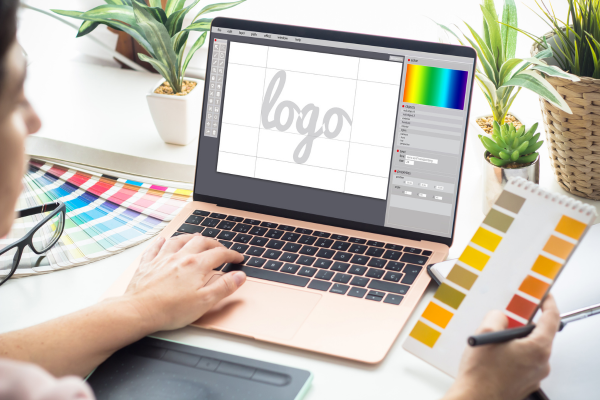In today’s fiercely competitive business landscape, a well-crafted logo plays a pivotal role in encapsulating a company’s brand identity. Serving as a visual ambassador, a logo communicates a brand’s values, personality, and essence to its target audience. Consequently, the process of logo design requires meticulous consideration and expertise.
This article delves into the significance of logo design, the key elements involved, and how designers can aid businesses in developing distinctive and representative logos that leave a lasting impact.
I. Understanding the Importance of Logo Design
A. The Role of a Logo in Brand Recognition and Differentiation In a saturated marketplace, a logo acts as a potent tool for brand recognition. A thoughtfully designed logo distinguishes a company from its competitors, contributing to the establishment of a strong visual identity. It serves as a symbol that customers associate with the brand, fostering a sense of familiarity and trust.
B. The Psychological Impact of a Well-Designed Logo on Consumer Perception Research indicates that consumers form immediate judgments about a brand based on its logo. A professionally crafted logo has the power to evoke positive emotions and shape consumer perceptions. By incorporating appropriate colors, shapes, and typography, designers can create logos that resonate with the target audience, eliciting feelings of trust, credibility, and appeal.
C. The Connection between a Logo and Brand Storytelling A logo possesses the potential to narrate a brand’s story in a visual and concise manner. Through carefully chosen design elements, a logo can encapsulate a brand’s essence, values, and unique selling propositions. Whether through symbolism, typography, or imagery, a well-executed logo effectively conveys a brand’s narrative, enabling customers to forge a connection with its purpose and offerings.
II. Elements of an Effective Logo Design
A. Simplicity and Memorability: Crafting a Logo That Is Easily Recognizable and Leaves a Lasting Impression Simplicity is paramount in logo design. A clean and uncluttered logo facilitates swift recognition and ensures ease of recall. Memorable logos possess a distinctive visual appeal that captures the audience’s attention, leaving an indelible imprint in their minds. By focusing on essential elements and eschewing complexity, designers can fashion logos that are memorable and instantly recognizable.
B. Relevance and Appropriateness: Ensuring the Logo Aligns with the Brand’s Values, Industry, and Target Audience An effective logo should be congruent with the brand it represents. It should convey the brand’s values, industry, and target audience. Designers must possess a comprehensive understanding of the brand’s identity, values, and target market to create a logo that harmonizes with these factors. This guarantees that the logo resonates with the intended audience and effectively communicates the brand’s message.
C. Visual Appeal and Aesthetics: Selecting Harmonious Colors, Typography, and Visual Elements that Resonate with the Brand Visual appeal plays a vital role in logo design. The meticulous selection of colors, typography, and visual elements can evoke specific emotions and create a powerful visual impact. Designers must consider the brand’s personality, industry, and target audience when making these choices. Harmonious color palettes, appropriate fonts, and visually captivating graphics enhance the overall aesthetics of the logo, making it visually engaging and memorable.
III. The Logo Design Process
A. Research and Discovery Prior to embarking on the logo design process, thorough research and discovery are imperative. Designers must comprehend the brand’s vision, target audience, and competition. They need to delve into the brand’s story, values, and unique selling propositions. Additionally, conducting industry analysis and staying abreast of design trends ensures the logo remains relevant in an ever-evolving market.
B. Sketching and Conceptualization Once armed with insights, designers commence brainstorming and sketching logo concepts. This phase allows for the exploration of diverse design ideas, creative solutions, and visual representations of the brand. Sketching enables designers to give shape to initial concepts, facilitating experimentation and the refinement of ideas.
C. Digital Design and Refinement After selecting promising concepts from the sketching phase, designers transition to the digital design stage. Utilizing design software, they translate chosen concepts into digital formats, refining the logo’s details, proportions, and color schemes. Iterative feedback loops with the client enable designers to incorporate necessary adjustments and refinements, ensuring the final logo aligns with the brand’s expectations.
D. Finalization and Delivery Once the logo design is finalized, it is presented to the client for approval. Designers provide the necessary logo files in different formats, including vector files, high-resolution images, and various color variations. These files equip the client to utilize the logo across diverse mediums, guaranteeing consistency and versatility in its usage.
IV. Collaboration between Designers and Businesses
A. Establishing Clear Communication Channels to Understand the Brand’s Vision and Requirements Effective collaboration between designers and businesses necessitates open and transparent communication channels. Designers should engage in comprehensive discussions with the client to grasp their brand’s vision, values, target audience, and specific design requirements. Regular updates and feedback sessions ensure the design process remains aligned with the client’s expectations.
B. Nurturing a Collaborative Relationship Built on Trust and Feedback A robust and collaborative relationship between designers and businesses is pivotal for successful logo design. Designers should cultivate an environment that encourages open dialogue, constructive criticism, and mutual trust. By incorporating client feedback into the design process, designers refine their work, ensuring the final logo accurately represents the brand.
C. Incorporating the Client’s Feedback to Refine the Logo Design Feedback plays an integral role in the logo design process. Designers should carefully consider and integrate the client’s feedback to refine and enhance the logo design. By addressing the client’s concerns and incorporating their suggestions, designers ensure the final logo aligns with the client’s expectations and faithfully represents their brand.
V. Showcasing Successful Logo Design Examples A. Case Study 1: How a Redesigned Logo Helped a Startup Establish a Strong Brand Presence This case study examines how a startup reimagined its logo to better align with its brand values and target audience. The redesigned logo played a significant role in establishing a cohesive brand identity and capturing the attention of its target market.
B. Case Study 2: The Evolution of a Renowned Brand’s Logo and Its Impact on Consumer Perception This case study delves into how a well-known brand evolved its logo over time to remain relevant and resonate with shifting consumer preferences. Strategic logo updates played a pivotal role in maintaining brand recognition and adapting to evolving market dynamics.
Conclusion
Designing a logo is a multifaceted process that demands creativity, strategic thinking, and collaboration between designers and businesses. A well-designed logo possesses the power to leave a lasting impression, foster brand recognition, and effectively communicate a company’s values to its target audience. By comprehending the significance of logo design, the key elements involved, and fostering robust collaborations, designers can assist businesses in creating unique and representative logos that accurately reflect their brand identities. With the right expertise and a discerning eye for design, designers play a vital role in shaping the visual representation of a brand and contributing to its success in the fiercely competitive market.



